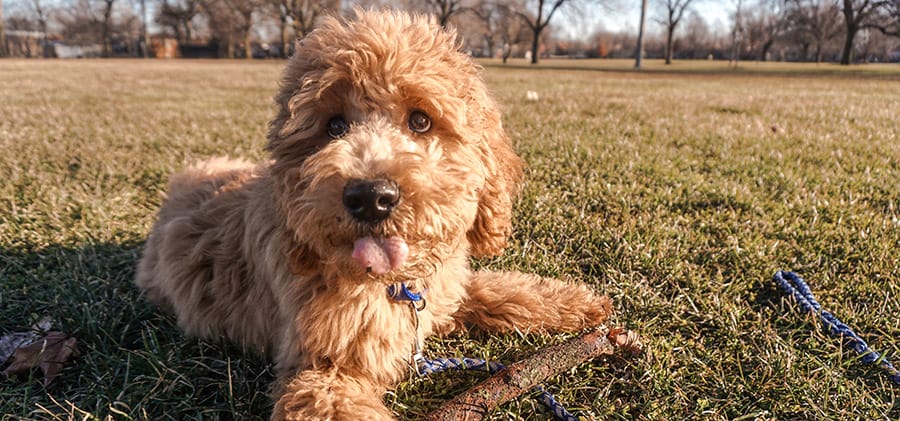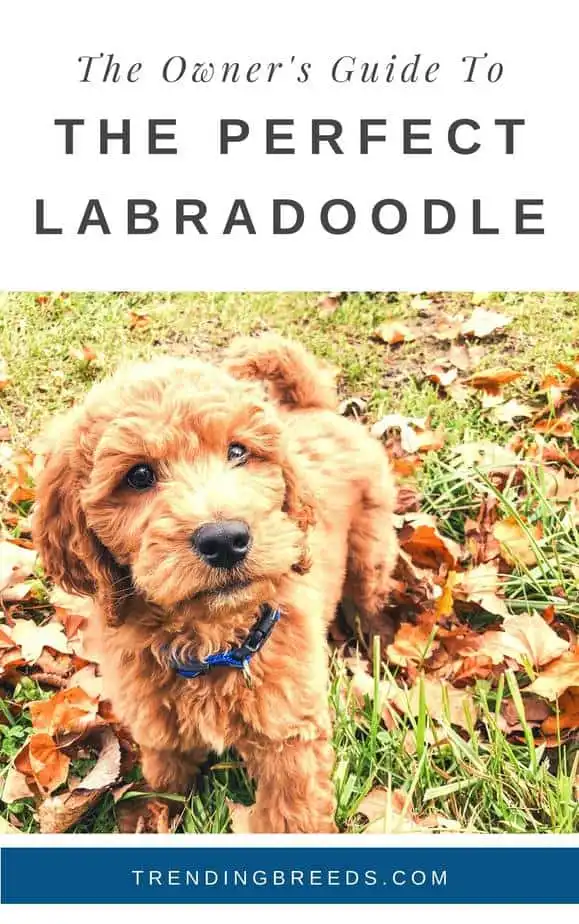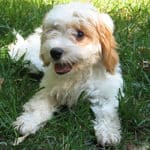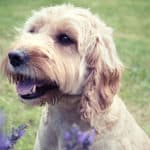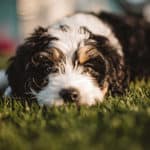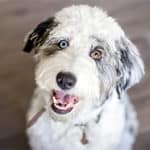Labradoodle puppies have such an adorable, soft coat you want to just reach out and touch it. Unfortunately, they don’t keep that particular coat all their lives.
This is just a puppy coat, and puppies eventually lose their puppy coats, but the question is when.
So, when do Labradoodle puppies lose their puppy coat? Labradoodle puppies typically start to shed their puppy coat and transition into their adult coat at 6 to 12 months old. This can vary depending on the type of coat the Labradoodle has (Fleece, Hair, or Wool).
As the adult coat grows in and the puppy coat sheds, it is more important than ever to brush the dog regularly. Brushing helps remove the puppy coat, which if left to tangle with the incoming adult coat, will cause mats.
If you’re thinking of getting a Labradoodle puppy or currently have one, you probably have a ton of questions, not just about puppy coat, but about all other aspects of raising your little buddy as well.
I know I did.
After raising two Labradoodles myself, I wanted to share what I learned along the way with new owners to help them avoid the trial-and-error approach to raising a puppy.
I’ve compiled tons of information into one, easy-to-read book full of helpful tips and advice.
In The Owner’s Guide To The Perfect Labradoodle, you’ll learn all about:
- Working with a breeder.
- Adopting a rescue.
- Puppy proofing.
- Temperament and physical features.
- What to expect in the early days.
- Crate training, housebreaking, and reward-based training.
- Exercise guidelines and mental stimulation.
- The importance of correct socialization.
- General health and nutrition.
- Veterinary care.
- Shedding and grooming.
- And so much more.
If you’re interested in raising the best possible dog, developing a strong bond, and giving your dog what he needs to truly thrive, this is the book for you – the only book you’ll need.
As an owner of 2 Labradoodles myself, I know how tough it can be to find good information. In the 60+ pages of this book, I share the information, resources, and breed-specific tips I wish I’d had from the start. You will save you time, money, and loads of frustration…take my word for it!
Grooming Tools Every Labradoodle Owner Should Have
- Comb – When just a puppy, a comb should work just fine. We use this stainless steel Poodle comb. One side is narrow and the other wide. It works great! And since it’s metal, it doesn’t create static.
- Brush – We use a Furminator® slicker brush.
- De-Matting Comb – Mats and tangles are bound to happen at some point in your pup’s life. When they do, and the normal comb or brush can’t get them out, you’ll need to bring in the de-matting comb. We use this Safari De-Matting Comb. (Caution: these have a sharp side to them; make sure you read the instructions so you don’t hurt your pup).
- Detangler – This can be used along with the comb or de-matting comb to help loosen problem tangles and mats. We love the Cowboy Magic® Detangler & Shine. It’s a little expensive, but it will more than pay for itself in grooming costs and headaches.
You can find some of our favorite grooming tools and supplies here.
Do Labradoodle Puppies Shed?
If there are one or two things that you’ve probably been told about Labradoodles, it’s probably that they don’t shed and they’re allergy-free or hypoallergenic dogs.
While there is some truth to both of these statements, they’re also not 100% accurate because all dogs shed to some degree, and a 100% hypoallergenic dog does not exist.
With that said, Labradoodles are as close to a hypoallergenic dog as you’re going to get.
Although Labradoodles do shed to some degree (more details on shedding here), it’s not shedding in the fashion we typically see in dogs.
For instance, a German shepherd will shed its coat twice a year. When the Shepherd “sheds out” its hair, you’ll see both loose hair and clumps of hair almost everywhere.
(Shepherds are amazing dogs, very different from Labradoodles in many ways, not just shedding. Learn more about them in these articles.)
Labradoodles don’t “shed out” their coat in the same way. They lose their hair while it’s being brushed.
When you brush or comb your Labradoodle, you’re getting rid of the old dead coat to make room for the new coat.
Failure to comb the coat with some regularity will result in the new coat matting as it’s coming in. Matting is a clump of tangled hair that is difficult to comb through.
If they get too serious, a groomer will have to cut out patches of hair.
Genetics plays a part in determining how much hair a Labradoodle will shed or lose.
Second (F1b) generation, third-generation (F3b) and multigenerational Labradoodles are going to shed less than a first-generation Labradoodle (F1).
Some owners will actually look for a second, third, or multigenerational Labradoodle dog just for the non-shedding or low-shedding attributes.
(Read this for a more detailed look at multi-generational Labradoodles.)
Labradoodles of any generation will lose some of their hair as they’re going from puppy to adult.
Australian Labradoodles are usually a good choice for people looking for asthma and allergy-friendly dogs.
Of the various types of Labradoodles, the wool-coated Labradoodle has had the highest success rate for people suffering from asthma or dog-related allergies.
When Do Labradoodles Start Shedding Their Puppy Coat?
Labradoodle puppies have a coat that is very soft and fairly easy to care for, especially if it’s combed or brushed often. Unfortunately, they don’t keep this coat forever.
They go through a coat change where their puppy coat changes to an adult coat.
This can take place as early as six months or as late as 10 months, but it’s safe to say the shedding process begins from 6 to 10 months of age.
When this shedding process begins, the coat will begin to fill out and will get thicker.
If the puppy is not brushed daily, the coat will become very matted and tangled.
A slicker brush, like this self-cleaning option, usually works very well for brushing the Labradoodle puppy’s coat.
Keeping the Labradoodle puppy’s hair looking good during this process can be very difficult if it’s not taken care of daily.
It’s important to brush right down to the skin.
If you don’t get right to the skin and get out all the old, dead skin, it can mat up below the surface, and you’ll have a real mess.
You’re not actually brushing the coat but are more pulling the old hair out. The more hair you see coming out in the brush, the better the puppy will look.
Some Labradoodle owners don’t want to deal with the mess and take their pup to a professional groomer.
Other owners use this opportunity as a way to bond with the dog and become familiar with the brushing process, which should become a regular part of their lives.
When Do Labradoodles Stop Shedding Their Puppy Coat?
The age at which Labradoodles stop shedding their puppy coat depends on the age it began the shedding process.
It can take from a week to several weeks, and every dog does it at a different age.
One puppy may be shedding its puppy coat between the ages of 6-12 months while another may be from 10-14 months of age.
If you suddenly realize your Labradoodle puppy is in need of a good haircut, the pup has probably begun the shedding process.
The importance of brushing the pup’s coat daily during this process cannot be stressed enough.
Labradoodle dogs don’t shed hair in the traditional fashion. Keep in mind that by pulling the old coat out, you’re getting rid of it and preventing it from matting up.
Don’t be surprised if your Labradoodle puppy suddenly has a whole new look.
Changing from a puppy coat to an adult coat can bring an entirely different color texture and overall appearance.
Looking at your pup’s parents will often give you a good idea of what your Labradoodle will look like as an adult.
Common Misconception About Shedding and Allergies
A common misconception regarding dog allergies is that it’s the dog’s hair that causes the allergic reaction.
While it is true that some people may have an allergy to dog hair from certain breeds of dogs, the allergic reaction is usually coming from the dog’s dander or allergens.
All dogs create allergens or proteins, which are what usually cause allergies. A dog’s allergens can be found in their dander, hair, saliva, and urine.
A dog that’s kept indoors is generally going to produce more allergens than one kept outdoors.
If pollen or dust accumulates in a dog’s hair, that can cause allergic reactions as well.
It’s important to remember that the person is more likely allergic to the dust or pollen than to the dog or the dog’s coat.
Because Labradoodle’s coats have a low level of allergens and are usually brushed and trimmed regularly, they’re known as being hypoallergenic.
What are the Different Types of Labradoodle Coats?
Labradoodles have three types of coat: hair, fleece, and wool. If you’ve ever seen Labradoodles, you’ve probably thought that they come in a lot more types than just these three.
There are two reasons for this. One reason is that Labradoodles come in many, many different colors.
Secondly, while there are only three types of coats, there is some variation within the different coat types.
Hair
The Labradoodle’s hair coat texture may be scruffy, wavy or feathering.
Depending on the length and density of the hair, Labradoodles with a hair coat should be brushed at least once a month.
Although it’s rare, they may need a slight trimming occasionally.
Due to its resemblance to the Labrador Retriever, the hair coat is the one that sheds the most and will be the least hypoallergenic.
Fleece
The fleece coat may be normal fleece or microfine fleece.
Normal fleece has the texture of soft angora and may be wavy or have loose spirals. In addition to being brushed every couple of weeks, this coat requires trimming once or twice a year.
Also wavy or spirally, the microfine fleece is very fine and super soft. Because of the texture, it tends to get matted easily. It will need a good brushing or combing at least once a week.
The coat should also be trimmed a couple of times a year to prevent it from growing past three inches. Both types of fleece coats are said to be asthma- and allergy-friendly coats.
Wool
The wool coat comes in three types: original wool, cotton wool, and loose or new style wool.
Original wool is dense and curly with the texture of a lamb’s wool.
Cotton wool is super dense, may be straight or curly and is the softest of the three wool coats.
When groomed, it stands up and often has the appearance of a big cotton ball. It should be brushed/combed at least once a week.
New style or loose wool is a spiral coat with the texture of lamb’s wool and needs to be trimmed a couple times per month.
Each of these wool types are asthma- and allergy-friendly coats with the original wool having the most success in this area. All three require regular trimming.
You can find even more information on Labradoodle coat types in this article.
Still have questions about your puppy?
Be sure to grab your copy of our Labradoodle Guidebook to find the answers and get your puppy on his way to becoming a well-adjusted, affectionate, happy adult.
Related Questions:
What is an Australian Labradoodle?
Labradoodles, which are a mixture of the Poodle and Labrador Retriever, were first created in an attempt to develop an allergy-friendly dog that didn’t shed.
The Australian Labradoodle was developed to create a dog that possessed the Labradoodle’s hypoallergenic qualities as well as other desirable traits.
This was done by mixing American or English Cocker Spaniels with Labradoodles.
To be a true Australian Labradoodle, the dog must be a mixture of these three dogs: Labrador Retriever, Poodle, and American or English Cocker Spaniel.
How many years do Labradoodles live?
Labradoodles are a relatively healthy breed of dog. While they are susceptible to some canine diseases, a healthy Labradoodle will generally live to be 11 to 14 years old.
Poodles generally live longer than Labrador Retrievers, so it’s been said that Labradoodles get their longevity from the Poodle side.
Conclusion
If you’ve been considering getting a dog but dog hair is an issue, you might find the Labradoodle to be an ideal choice.
Imagine the joy of having a family pet that’s not only intelligent, loyal, and playful but also one that can be kept in your home without the fear of non-stop dog hair everywhere.

